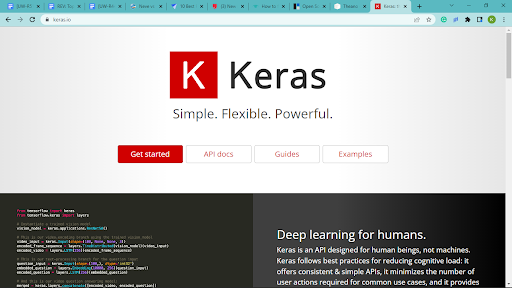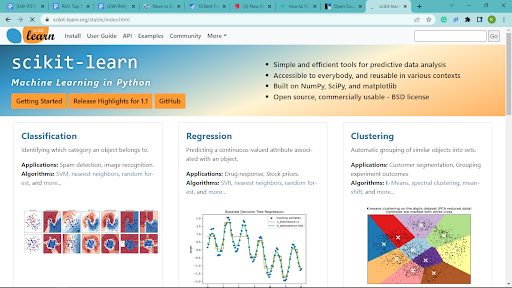
Learning has always been an integral part of development. From early civilization, humans have learned new skills to adapt to and transform their environment.
According to the UNESCO publication, education is crucial for transforming the future. But as the world advances in tech, it becomes more clear how machine learning also plays a vital role in advancing a better future.
Empowering machine models and algorithms to self-learn improves their ability to make more accurate decisions and predictions. In turn, these machines can power emerging technologies like self-driving cars, robotics, and medical diagnostics.
The first step to building these machine models is to master relevant programming frameworks. Follow this tutorial to learn more about the top five machine learning frameworks for AI and deep learning.
Top machine learning frameworksMachine learning frameworks are interfaces or libraries that enable developers to build machine learning models faster and easier without dealing with underlying algorithms. Here are some top frameworks developers use for deep learning and AI development projects.
1. TensorFlow

TensorFlow is an end-to-end open-source data science and machine learning library. Researchers at Google Brain Team originally developed the library for internal deep learning and machine learning research.
In 2017, Google launched TensorFlow 1.0 and made it open for public use. The library was characterized by its 58x speed and scalability. It contained APIs for Go and Java, which aided machine learning for mobile devices. The drawback, however, was that version 1.0 was low-level and had a cumbersome workflow.
Retaining its versatility and improving on simplicity and beginner-friendliness, Google launched TensorFlow 2.0. Google incorporated Keras into TensorFlow, giving it access to high-level APIs for building and training machine learning (ML) models. After building, the library’s flexibility allowed developers to deploy their models in various ecosystems, including web browsers, mobile devices, and larger data systems.
TensorFlow also provides a rich set of tools and pipelines to develop and train several deep neural networks simultaneously. Common applications of TensorFlow for beginners are building and training high-performance machine learning applications for image classifiers and recommender systems for social platforms.
Features
Comes with the TensorFlow.js library that allows you to deploy machine learning models directly to your web browser and run in a JavaScript environment like Node.js
With TensorFlow Lite, developers can deploy the framework on iOS, Android, and IoT (internet of things) devices, and also on ML models on cloud infrastructures, like Microsoft Azure and Amazon Web Services (AWS)
TensorFlow provides eager execution, which processes tensors and smaller code units and provides output immediately (instead of waiting to complete the entire model)
Pros
TensorFlow natively supports training acceleration with graphics processing units (GPUs) and tensor processing units (TPUs), which are natively unavailable with other frameworks like scikit-learn
TensorFlow can operate as a back-end framework to Keras when dealing with a high-level environment and can function independently for low-level computations
The library has vast functionalities and high performance when dealing with large datasets
TensorFlow supports various object-oriented languages like Python, Java, JavaScript, and C++
Cons
Despite requiring smaller storage space, TensorFlow takes more time to train machine learning models compared to PyTorch and Theano
TensorFlow only supports NVIDIA and Python programming languages for accelerating models on GPUs
Unlike Keras and Theano, which can use any of Python’s debugging tools, TensorFlow uses only a special debugging tool
2. Keras

Keras is a high-level framework that provides an interface for machine learning and deep learning processes. Keras was created to achieve faster experimentation. The framework can simultaneously run models on your system’s Central Processing Unit (CPU) and Graphics Processing Units (GPU), accelerating the training process.
Since Keras was written in Python, it inherited simple syntax and modular programming, making it beginner-friendly. Keras is simple, providing numerous easy-to-use APIs and reducing the number of codes users need to complete various machine learning tasks.
Besides its simple APIs, Keras shows excellent flexibility and can run on top of other open-source frameworks like Microsoft CNTK and Theano. Companies like Uber, Netflix, and Square use Keras frameworks to create deep learning models for their mobile apps.
Features
Keras is modular, containing pre-defined functions, variables, and modules that make computing codes easier when building deep learning applications and models
Keras allows you to export models to JavaScript to run them directly in the browser for various Android and iOS devices
The framework has numerous prelabeled datasets, allowing users to access and train easier
Pros
Keras is an excellent choice for projects where researchers want to quickly build, train, and deploy models
Keras is great for fast prototyping and can support various operating systems, including Linux, macOS, and Windows
When compared to TensorFlow, Keras has more debugging functionalities and toolkits
Keras has a vast community of developers and robust documentation and tutorial materials that allow beginners to soft pedal into deep learning
Cons
Although Keras can provide interfaces for TensorFlow and Theano, it cannot stand alone—it needs a back-end framework to function
Relative to TensorFlow, Theano, and PyTorch, Keras is slow and requires more time to process algorithms and train deep learning models
Keras often give errors in low-level environments, like when handling some complex mathematical computations
3. PyTorch

PyTorch is a deep learning framework developed from Facebook AI research in 2018. The framework was built using Python and Torch, a scientific computing framework based on the Lua programming language.
By design, PyTorch enables research in high-performance and low-latency applications. The library helps build and train neural networks and deep learning algorithms end to end. Being a low-level framework, PyTorch is excellent for handling numerical computations, making it a choice program for mathematicians and statisticians looking for a superior environment to run deep learning algorithms.
PyTorch provides a rich collection of tools, making it useful for machine learning, deep learning research, prototype building, computer vision, and natural language processing (NLP). Scientists and engineers worldwide use PyTorch in various industries, including automotive, health care, finance, and more.
Features
PyTorch allows data parallelism, meaning users can distribute computational operations between several CPUs and GPUs, making them process data simultaneously
PyTorch is a back-end framework but works with C++ for front-end interfacing and Python for its architecture
PyTorch has solid compatibility with NumPy, making it an excellent library for converting NumPy objects to tensors
Pros
PyTorch eases debugging processes thanks to its Python IDE and other debugging tools
You can optimize models in between deploying or training a model with PyTorch
PyTorch has a number of resources to create an ecosystem for accelerating artificial intelligence research and development processes
PyTorch supports several libraries and APIs that extend its capabilities, like having the Open Neural Network Exchange support for exporting models faster
PyTorch is Pythonic, meaning it follows the syntax and convention of the Python programming language and is easy to learn
Cons
PyTorch is not as extensive as TensorFlow and does not cover end-to-end model building to deployment functions
PyTorch has limited features for creating a graph for deep learning models, making users connect to external frameworks for more extensive visualization
4. Microsoft NLTK

Microsoft Natural Language Toolkit (NLTK) is a comprehensive natural language processing toolkit developed by Steven Bird and Edward Loper. The library was created to advance research in machine learning, natural language processing, and other related fields like computational linguistics and information retrieval.
The framework provides numerous algorithms for natural language text processing tasks like text classification, tagging, stemming, and lemmatization. As a Python-based library, NLTK is open-source and provides extensive documentation that guides you on using it for various machine learning and data science tasks.
The framework is available on Windows, Linux, and macOS operating systems. Machine learning developers use the framework to build chat boxes and identify sentiments in reviews and natural language.
Features
Microsoft NLTK offers a wide range of tools for text processing, including tokenization, part-of-speech tagging, Named Entity Recognition, and parsing
The framework has several trained models and data corpora that aid text processing
Pros
The library supports integration with various lexical resources like WordNet to aid language processing
NLTK offers flexibility with language as it provides compatibility with numerous languages, including English, Spanish, French, German, and Chinese
NLTK operates with the Apache 2.0 license, which allows commercial application of the framework
The framework is taught in various schools
Microsoft NLTK codes are simple and easy to apply, making the library an excellent choice for practical or research-intensive learning
Cons
The library does not break text into sentences for semantic analysis but only runs syntactic analysis
NLTK has a relatively slow performance when implementing models compared to natural language frameworks like SpaCy
5. Scikit-learn

Scikit-learn started as a Google Summer of Code project in 2007. Later on, several other developers worked on the project to produce a more extensive framework, which was released to the public in 2010.
Scikit-learn builds on several Python libraries like NumPy, matplotlib, Pandas, and SciPy. The machine learning framework provides various classification, regression, and clustering algorithms. Further, it has a comprehensive toolkit for predicting future events based on analyzed data. Companies like Spotify and J.P. Morgan use this framework for various machine learning applications, including recommender systems, prediction models, and data clustering software.
Feature
Scikit-learn contains an extensive collection of supervised learning algorithms, including models for linear regression and decision trees
Scikit-learn has numerous helper functions, like the hyperparameter and data preprocessing tools
The dimensionality reduction feature allows you to reduce the number of attributes in a dataset using visualization and summarization methods
Pros
Scikit-learn is easy to use
With scikit-learn, you can define and compare machine learning algorithms and processes
The framework has extensive documentation that guides users through how to use the library
Scikit-learn is versatile and relevant for various processes, like creating neuroimages and predicting customer behavior
The framework has a vast community and numerous authors—as a result, it gets frequent updates
Cons
The simple abstraction may tempt beginners to skip machine learning foundations
Scikit-learn is not suitable for string processing
Source: upwork
Original Content:
https://www.upwork.com/resources/top-machine-learning-frameworks